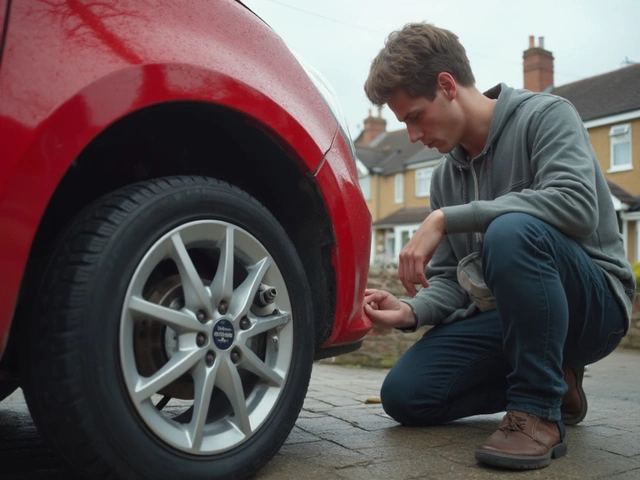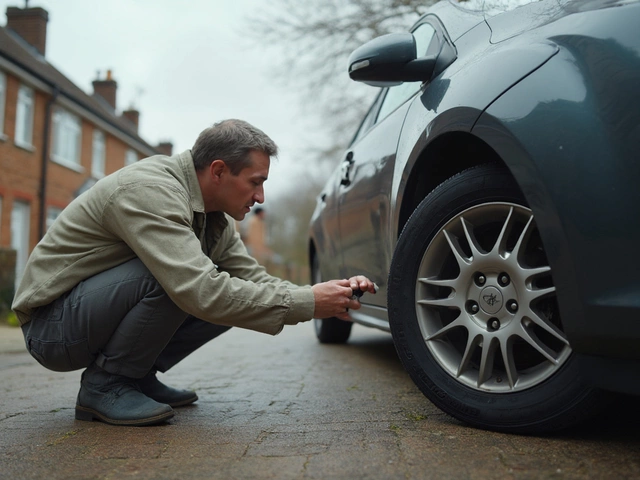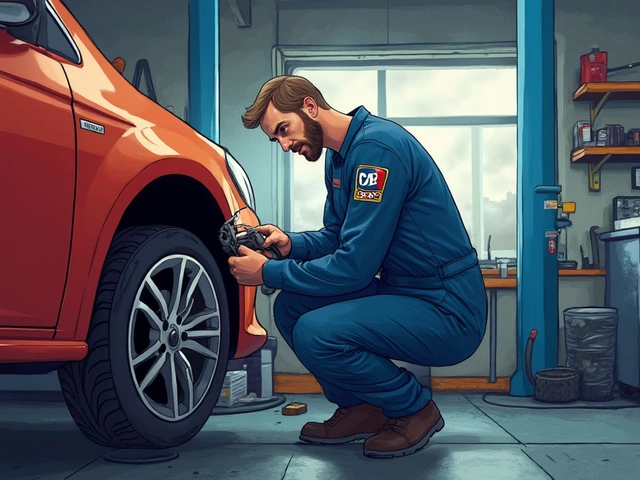Brake Rotor Condition Checker
Check Your Brake Rotor Condition
You hear a squeal when you brake. Maybe the pedal feels spongy. Or you notice a vibration through the steering wheel. Your first thought? Brake pads are worn. And maybe you’re right. But here’s the question most drivers get wrong: do you need new rotors too, or can you just swap the pads?
The answer isn’t simple. It depends on how your brakes have been treated, how many miles you’ve driven, and whether you’ve ignored warning signs for too long. Skip the guesswork. This guide shows you exactly what to check, when to replace what, and how to avoid getting overcharged at the garage.
What Brake Pads and Rotors Actually Do
Brake pads and rotors work together. The pads clamp down on the rotors - the metal discs attached to your wheels - to slow you down. Every time you brake, a tiny bit of pad material rubs off onto the rotor surface. That’s normal. But over time, both parts wear out.
Brake pads are designed to wear first. They’re the cheaper, easier-to-replace part. Rotors are heavier, more expensive, and built to last longer - but they’re not indestructible. If pads are left too long, they can dig into the rotor. That’s when things go wrong.
When You Can Get Away with Just Replacing Brake Pads
You don’t always need new rotors. In fact, if your car has under 50,000 miles and you’ve kept up with regular brake checks, you might only need new pads.
Here’s when it’s safe to skip rotor replacement:
- The rotors look smooth and even, with no deep grooves or blue discoloration.
- The thickness is above the manufacturer’s minimum specification (usually stamped on the rotor edge - often around 2.8mm for most UK cars).
- You haven’t heard grinding noises, just light squeaking or squealing.
- Your brake pedal feels firm, not spongy or pulsing.
Many independent garages in Manchester will offer a pad-only replacement if the rotors pass inspection. It’s a perfectly valid service - as long as the rotors are still in good shape.
When You Definitely Need New Rotors
Now, here’s the scary part: if you ignore worn pads, you’ll damage the rotors. And once that happens, no amount of pad replacement will fix the problem.
You need new rotors if:
- You hear a loud, metallic grinding sound - like metal on metal - when braking. That’s the pad backing plate scraping the rotor.
- The brake pedal pulses or vibrates when you press it. This means the rotor is warped or unevenly worn.
- The rotor surface has deep grooves, cracks, or bluish heat spots. These aren’t just cosmetic - they affect braking performance.
- The rotor thickness is below the minimum safe level. Measure it with a micrometer or ask a mechanic to check. If it’s worn past spec, it’s unsafe to reuse.
- You’ve driven more than 70,000 miles without a brake service.
One real-world example: a 2018 Ford Focus I worked on last spring had pads worn down to 1mm. The rotors were scored so badly they looked like they’d been filed with a rasp. Replacing just the pads would’ve been dangerous - the warped rotors would’ve caused the new pads to wear unevenly and overheat within weeks.
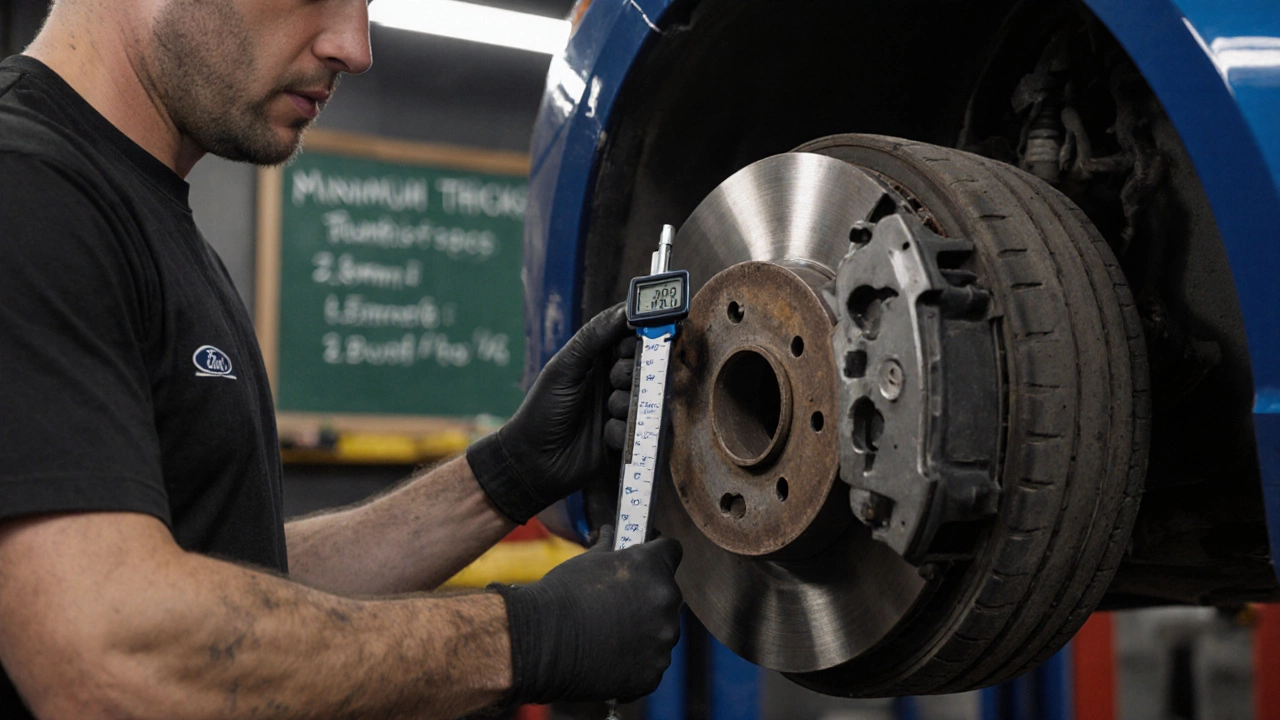
How to Check Your Rotors Yourself
You don’t need fancy tools to get a basic idea of rotor condition. Here’s how:
- Remove the wheel. You’ll need a jack, jack stands, and a lug wrench. Safety first - never rely on a jack alone.
- Look at the rotor surface. Is it shiny and smooth? Good. Are there deep grooves or ridges? Bad.
- Run your finger across the surface. If you feel a lip or ridge at the edge, that’s a sign of uneven wear. This happens when pads wear unevenly or the caliper sticks.
- Check for discoloration. Blue or dark patches mean the rotor overheated - often from dragging brakes or aggressive driving.
- Use a ruler or tape measure. Measure the thickness at several points. Compare it to the minimum thickness stamped on the rotor. If it’s close to or below that number, replace it.
Most modern UK cars have rotors that last 30,000-70,000 miles. But if you drive in stop-and-go traffic in Manchester or Leeds, or you’re a heavy brake user, your rotors might need replacing closer to 40,000 miles.
What Happens If You Replace Pads But Not Rotors?
Some mechanics will tell you it’s fine to reuse rotors if they’re “still within spec.” That’s technically true - but it’s not always smart.
Here’s what can go wrong:
- Reduced braking power: Old, worn rotors don’t grip new pads as effectively. You’ll need to press harder to stop.
- Noise: Even new pads can squeal if they’re riding on a damaged rotor surface.
- Uneven wear: If the rotor is warped or grooved, the new pads will wear out faster on one side. You’ll be back in the garage sooner.
- Overheating: Damaged rotors can’t dissipate heat properly. This leads to brake fade - especially on long downhill drives.
One driver I spoke to in Salford replaced his pads but kept the rotors. Six weeks later, the brakes started pulsing. He had to pay for both pads and rotors - plus a wheel alignment - because the warped rotors had thrown off the caliper alignment. He ended up spending £180 more than if he’d replaced both at once.
Cost Comparison: Pads Only vs. Pads and Rotors
Let’s be real - rotors cost more. But here’s the real cost breakdown:
| Part | Cost Range (Parts Only) | Labour Cost (Per Axle) | Total Estimated Cost |
|---|---|---|---|
| Brake Pads Only | £40-£80 | £60-£100 | £100-£180 |
| Brake Pads + Rotors | £100-£200 | £80-£130 | £180-£330 |
Rotors aren’t cheap - but they’re not the villain. The real issue is delaying the job. If you wait until the rotors are ruined, you’re paying more in the long run. Plus, you’re compromising safety.
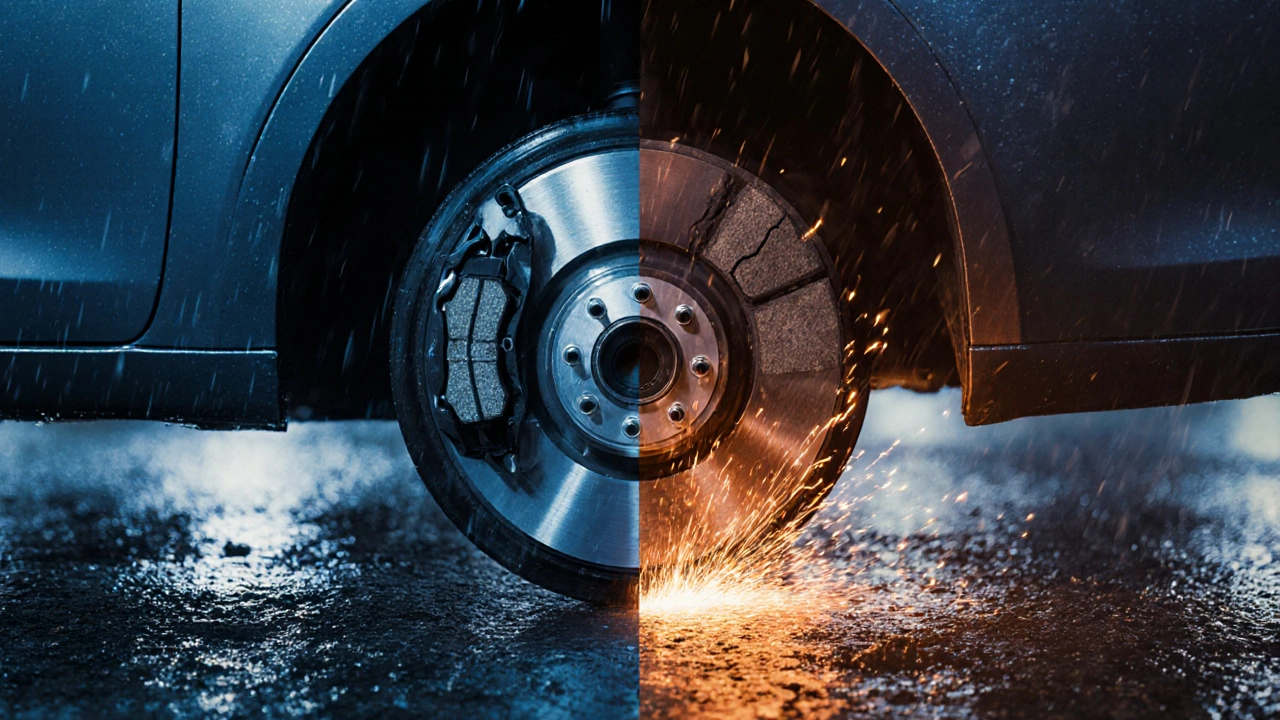
Pro Tips for UK Drivers
Here’s what works in real life, based on years of working on cars across northern England:
- Check your brakes every 10,000 miles. Don’t wait for noise or vibration.
- If your car is over 8 years old, assume the rotors are nearing the end of their life - even if they look okay.
- Don’t buy cheap, no-name rotors. Stick with OEM-spec or trusted brands like Brembo, ATE, or Mintex.
- Always replace pads and rotors in pairs - front or rear axle, never just one side.
- After replacement, bed in the new pads properly. Avoid heavy braking for the first 200 miles. Let them heat up gradually.
When to Take It to a Pro
If you’re unsure about measuring rotor thickness, spotting warping, or checking caliper function - get it checked. Brake systems are not DIY territory if you’re not confident.
Look for a garage with a brake lathe. If they can resurface your rotors instead of replacing them, that’s a cost-saving option - but only if the rotor is thick enough. Most modern rotors are too thin to be turned anymore. Many shops now recommend replacement over resurfacing.
And never let a garage pressure you into replacing rotors if they’re clearly still good. Ask to see the measurements. Ask to see the rotors. A reputable shop will be happy to show you.
Final Answer: Do You Need New Rotors or Just Pads?
Replace the pads if they’re worn. Replace the rotors if they’re damaged, thin, warped, or grooved. If you’re not sure - get them inspected. Don’t guess. Don’t risk it.
Brakes aren’t just about cost. They’re about control. They’re about stopping distance. They’re about your family’s safety on wet Manchester roads or icy A-roads in winter.
When in doubt, replace both. It’s not an upgrade - it’s the right thing to do.
Can I just replace brake pads without checking the rotors?
No. You should always inspect the rotors when replacing pads. Even if they look fine, they might be worn below the safe thickness or warped. Replacing pads without checking rotors can lead to poor braking, noise, or premature wear on the new pads.
How do I know if my rotors are worn out?
Look for deep grooves, bluish discoloration, or a visible lip on the edge. If the brake pedal pulses when you brake, that’s a sign of warping. Measure the thickness - if it’s below the minimum stamped on the rotor, it’s unsafe. Most rotors need replacing between 50,000 and 70,000 miles, but aggressive driving or neglect can shorten that.
Is it cheaper to resurface rotors instead of replacing them?
It used to be, but not anymore. Most modern rotors are too thin to be safely resurfaced. Even if a shop offers it, they’ll only turn them if they’re thick enough - which is rare on cars over 8 years old. Replacement is usually more reliable and often costs about the same.
How often should brake pads and rotors be replaced?
Brake pads typically last 30,000 to 60,000 miles. Rotors last longer - often 50,000 to 70,000 miles - but they can wear out faster if pads are ignored. Stop-and-go city driving, towing, or aggressive braking will shorten both lifespans. Regular inspections every 10,000 miles catch problems early.
Can worn rotors affect fuel economy?
Not directly. But if your rotors are warped or your brakes are dragging - which can happen if pads are worn and calipers stick - your car will have to work harder to move. That increases fuel consumption. A dragging brake can reduce fuel efficiency by up to 5%, especially in urban driving.
